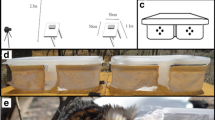Vespula germanica foragers return to a food source that has not been depleted. In this work we investigate how long wasps continue searching for a food source that is no longer available. We first trained wasps to feed on a dish surrounded by four yellow cylinders, and then, during the testing phase, we removed the food, and recorded foragers’ behavior until wasps stopped visiting the array. Two groups received different treatments: one received one feeding trial and the other three. Wasps trained with three consecutive trials searched over the original array approximately three times longer than those receiving one. Furthermore, the number of hovers and landings over the array was significantly higher for wasps trained with three trials than for wasps trained with one. Finally, initial level of response (i.e. number of hovers and landings in the first visit during the testing phase) was significantly higher in the group with three trials than in the group with one. We discuss the biological significance of memory extinction in these generalist wasps, in relation to the level of uncertainty of the resources they exploit. The plasticity to extinguish differently an association between a stimulus and a food resource could be one of the various behavioral mechanisms in V. germanica wasps that had allowed the species to get successfully established in new areas of the world.


Similar content being viewed by others
REFERENCES
Archer, M. E. (1998). The world distribution of the euro-asian species of Paravespula (Hym., Vespinae). Entomologist’s Monthly Magazine 134: 279–284.
Bouton, M. E. (2004). Context and behavioral processes in extinction. Learn. Mem. 11: 485–494.
Collet, T. S., and Zeil, J. (1998). Places and landmarks: an arthropod perspective. In Healy S. (ed.), Spatial Representation in Animals. Oxford University Press, Oxford, New York, Tokyo, pp. 18–53.
D’Adamo, P., Corley, J., Sackmann, P., and Lozada, M. (2000). Local enhancement in the wasp Vespula germanica. Are visual cues all that matter? Insectes Soc. 47: 289– 291.
D’Adamo, P., Corley, J. C., and Lozada, M. (2001). Vespula germanica Heads Attract Conspecific Foragers. J. Econ. Entomol. 94(4): 850–852.
D’Adamo, P., Sackman, P., Rabinovich, M., and Corley, J. C. (2002). The potential distribution of German wasps (Vespula germanica) in Argentina. N.Z.J. Zool. 29: 79–85.
D’Adamo, P., Corley, J. C., and Lozada, M. (2003). Conspecifics enhance attraction of Vespula germanica (Hymenoptera: Vespidae) Foragers to food baits. Ann. Entomol. Soc. Am. 96(5): 685–688.
D’Adamo, P., Corley, J. C., and Lozada, M. (2004). An attraction pheromone from worker of Vespula germanica wasps. J. Insect Behav. 17(6): 809–821.
D’Adamo, P., and Lozada, M. (2003). The importance of location and visual cues during foraging in Vespula germanica wasps. N.Z.J. Zool. 30: 171–174.
Farji-Brener, A., and Corley, J. C. (1998). Successful invasions of hymenopteran insects into NW Patagonia. Ecología Austral 8: 237–249.
Gallistel, C. R., Fairhurst, S., and Balsam, P. (2004). The learning curve: Implications of a quantitative analysis. PNAS 101(36): 13124–13131.
Hall, G. (1994). Pavlovian Conditioning: Laws of association. In: Mackintosh, N. J. (ed.), Animal Learning and Cognition. Academic Press, San Diego, USA, pp. 15–43.
Jandt, J. M., and Jeanne, R. L. (2005). German yellowjacket (Vespula germanica) foragers use odors inside the nest to find carbohydrate food sources. Ethology 111: 641– 651.
Menzel, R., and Müller, U. (1996). Learning and memory in honeybees: From behavior to neural substrates. Annu. Rev. Neurosci. 19: 379–404.
Menzel, R. (1999). Memory dynamics in the honeybee. J. Comp. Physiol. A 185: 33–340.
Overmyer, S. L., and Jeanne, R. L. (1998). Recruitment to food by the German yellowjacket, Vespula germanica. Behav. Ecol. Sociobiol. 42: 17–21.
Pavlov, I. P. (1927). Conditioned reflexes: An investigation o the activity of the cerebral cortex. Lecture III, Oxford: Oxford UP, p. 60.
Raveret Richter, M. A., and Jeanne, R. L. (1985). Predatory behaviour of Polybia sericea (Olivier), a tropical social wasp (Hymenoptera: Vespidae). Behav. Ecol. Sociobiol. 16: 165–170.
Shettlewoth, S. J. (1994). Biological approaches to the study of learning. In Mackintosh, N. J. (ed.), Animal Cognition. Academic Press, San Diego, California, pp. 185–212.
Takagi, M., Hirose, Y., and Yamasaki, M. (1980). Prey-location learning in Polistes jadwigae Dalla Torre (Hymenoptera: Vespidae), field experiments on orientation. Kontyu 48(1): 53–58.
Zeil, J., Kelber, A., and Voss, R. (1996). Structure and function of learning flights in bees and wasps. J. Exp. Biol. 199: 245–252.
ACKNOWLEDGMENTS
We are grateful to Josué Nuñez for his valuable comments and to Juan Karlanian for field assistance. We also acknowledge the suggestions of two anonymous reviewers which highly improved the manuscript. This study was partially funded through a grant from CONICET (PIP 2005) and BID: PID 391/03. We also acknowledge support from the CRUB, Universidad del Comahue.
Author information
Authors and Affiliations
Corresponding author
Rights and permissions
About this article
Cite this article
Lozada, M., D’Adamo, P. How Long do Vespula Germanica Wasps Search for a Food Source that is no Longer Available?. J Insect Behav 19, 591–600 (2006). https://doi.org/10.1007/s10905-006-9045-0
Published:
Issue Date:
DOI: https://doi.org/10.1007/s10905-006-9045-0




